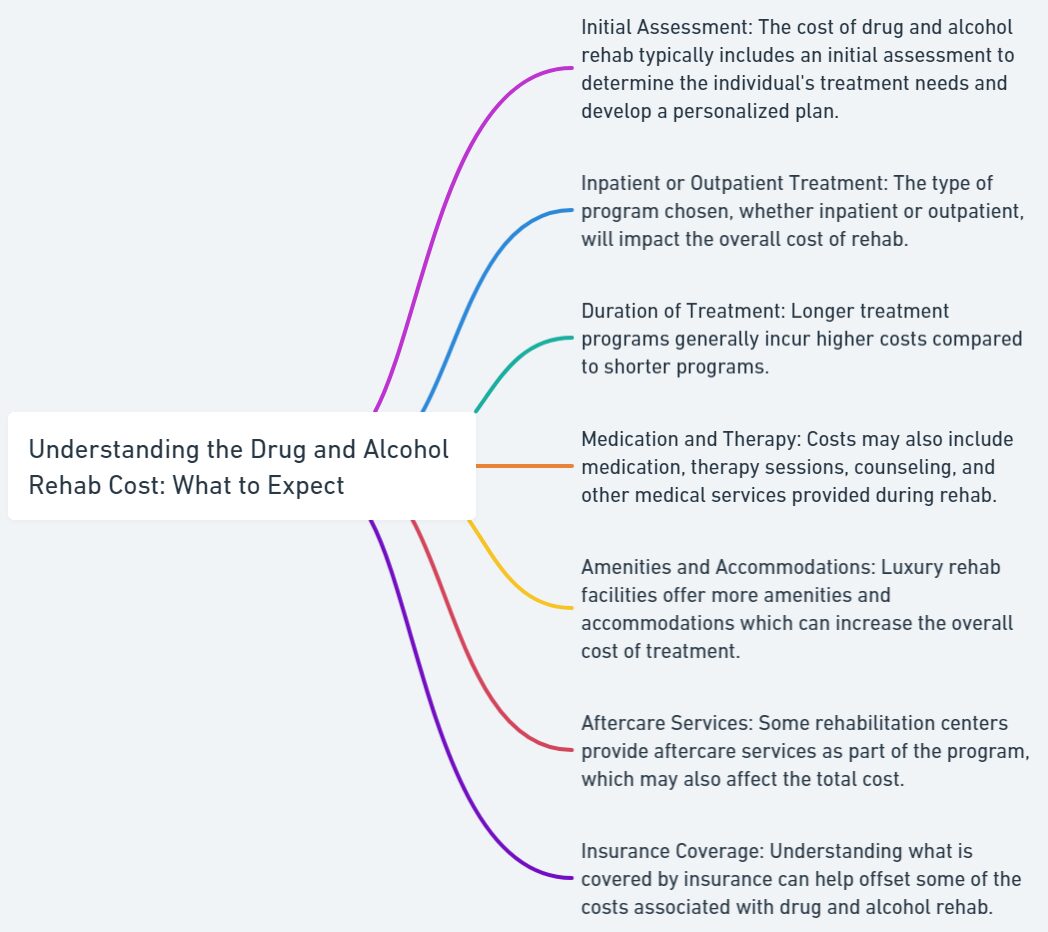Are you or a loved one considering drug and alcohol rehab but feeling overwhelmed by the potential drug and alcohol rehab costs? You’re not alone. The cost of rehab can be a significant barrier for many seeking addiction treatment. However, understanding the various factors that influence drug and alcohol rehab cost, the available insurance coverage options, and low-cost alternatives can help ease your concerns. This comprehensive guide will provide an overview of what to expect in terms of drug and alcohol rehab cost, insurance coverage, and affordable treatment options in 2023, so you can make a well-informed decision and start on the path to recovery.
Key Takeaways
- Drug and Alcohol Rehab Costs vary depending on the type of program selected, ranging from $250 to $1,000 per day.
- Insurance coverage has been made more accessible due to the Affordable Care Act of 2010. Public insurance options such as Medicaid and Medicare may also provide varying degrees of coverage.
- Low cost or free rehabilitation services are available through state funded programs, support groups and sliding scale fee structures for those without insurance or with limited financial resources.
The Cost of Drug and Alcohol Rehab: Breaking It Down
The cost of drug and alcohol rehab varies depending on several factors such as treatment type, location, amenities, and insurance coverage. Understanding these factors is vital when seeking addiction treatment for making an informed decision about your recovery journey. Generally speaking, a typical drug rehab like Lantana Recovery costs can be broken down into two categories: the average cost of inpatient treatment ranges from $5,000 to $50,000, while outpatient treatment typically costs between $1,000 and $10,000.
Factors like the level of treatment required, duration of stay, available services, transportation, and amenities can significantly impact the drug rehab cost. Additionally, the location, intensity of the program, and whether the treatment center accepts insurance further influence the cost of drug and alcohol rehabilitation. Keep in mind that each individual’s situation is unique, and the final cost of treatment can fluctuate based on these factors.
Insurance is the most prevalent payment option for rehab, with facilities offering cost-effective financing options based on individual situations for alcohol abuse treatment. Some rehab centers offer monthly scholarships to assist in covering treatment expenses, while patients may also apply for personal loans or use credit cards. Alternative payment options include paying for treatment without insurance assistance.
Detoxification Services
Detoxification is the first step in rehab, aimed at eliminating toxins from a person’s body and addressing their dependency on substances, including alcohol addiction. The cost of detoxification services can range from $250 to $1,000 per day, depending on the severity of addiction and the type of detox required.
There are various types of detoxification services available, such as medical detox, social detox, and outpatient detox. The cost of a detox program depends on factors such as whether the individual resides at the rehab center as an inpatient or attends the program as an outpatient. Understanding the various detox options and their associated costs is key to selecting the most suitable detox program for your needs.

Inpatient Treatment Programs
Inpatient treatment programs provide 24/7 care and support in a hospital or residential setting. The cost of inpatient treatment can range from $2,000 to $20,000 for basic treatment and up to $50,000 for luxury facilities. These programs offer benefits such as:
- Access to counseling
- Group therapy
- Detox services without delay
- Daily supervision to ensure the efficacy of the rehabilitation process
Take into account that the duration of inpatient treatment programs can differ. Short-term treatment in residential centers typically lasts 3 to 6 weeks, while long-term care in residential centers is usually 6 to 12 months. When contemplating inpatient treatment, weighing the costs and benefits of these programs is crucial to determine the most suitable option for your recovery journey.
Outpatient Treatment Options
Outpatient treatment options allow patients to live at home while receiving care. These programs can be more affordable than inpatient treatment, with costs ranging from $5,000 to $10,000 for a 3-month program, depending on the intensity of the treatment.
Outpatient programs can include intensive outpatient treatment, partial hospitalization programs, and alternative therapies such as acupuncture and meditation. The cost of outpatient rehab can vary based on factors like location, program intensity, and the specific services provided. Researching and comparing outpatient treatment options is crucial to find the most cost-effective and suitable program for your recovery needs.
Insurance Coverage for Rehab

Insurance coverage for rehab varies, with public insurance options like Medicaid and Medicare covering some costs, while private insurance plans may cover a larger portion of treatment expenses. The Affordable Care Act of 2010 made it easier for individuals with addiction issues to access cost-effective health insurance that covers therapy visits and rehab stays. Legislation is in place requiring insurance plans to cover treatment for mental health issues, such as substance use disorders. This ensures everyone has access to the care they need..
Before entering a facility or locating a healthcare provider, individuals with private insurance policies should consult their insurance provider to ascertain if any modifications have been made to their policies. Understanding your insurance coverage for rehab will help you make a well-informed decision about the best treatment option that suits your needs and financial situation.
Public Insurance Options
Public insurance options, such as Medicaid and Medicare, may cover some rehab costs, but coverage varies by state and individual eligibility. Public insurance typically covers a range of rehabilitation services, including:
- Substance abuse rehabilitation
- Mental health treatment
- Addiction treatment medication
- Clinic visits
- Alcohol and drug testing
- Home health visits
- Family counseling
- Anti-craving medication
Coverage for rehab can vary among states, with some states providing free rehab or state-funded rehab options to assist individuals in need. To access public insurance coverage for rehab, one must follow these steps:
- Ascertain eligibility for coverage.
- Collect the required documents.
- Complete the application.
- Submit the application.
- Wait for approval.
Contacting your local public health department or insurance agency for more comprehensive information and assistance with the application process is a crucial step.
Private Insurance Plans
Private insurance plans often cover a significant portion of rehab costs, but patients should check their specific policy for deductibles, co-payments, and coverage limits. Private insurance plans typically provide coverage for a variety of drug and alcohol rehabilitation services, including:
- Addiction treatment programs
- Clinic visits
- Alcohol and drug testing
- Home health visits
- Family counseling
- Medication for addiction treatment
There may be limitations or exceptions in private insurance plans for drug and alcohol rehab coverage, such as:
- Residential treatment restrictions
- Nonquantitative treatment limitations
- Differences in coverage between medical/surgical benefits and mental health/substance abuse benefits
Reviewing your specific insurance policy before seeking treatment is crucial to ensure you grasp the extent of coverage and any potential limitations.
Low-Cost and Free Rehab Alternatives

For those without insurance or with limited financial resources, low-cost and free rehab alternatives are available. These options include state-funded programs, support groups, and sliding-scale fee structures. Exploring these alternatives may help to reduce or eliminate out-of-pocket costs for rehab treatment, making the recovery process more accessible.
State-funded programs offer affordable addiction rehab services, including detox, inpatient and residential treatment programs, as well as outpatient treatment, and support for drug abuse, but may have limited availability and longer wait times at treatment centers. Substance abuse treatment options, such as alcohol rehab treatment and support groups like Alcoholics Anonymous and Narcotics Anonymous, provide free peer support and resources for individuals in recovery from substance use disorder.
Sliding-scale fee structures are offered by some rehab facilities, allowing patients to pay for treatment based on their income and financial situation.
State-Funded Programs
State-funded programs are financed by the state and offer low-cost or no-cost rehabilitation services. These programs provide a range of services, such as substance abuse rehabilitation, mental health treatment, and addiction treatment medication, depending on the specific state policies and programs.
While state-funded programs can help reduce the financial burden of rehab, they may have limited availability and longer wait times due to high demand for their services. Researching state-funded rehab options in your state and determining eligibility for services is crucial to make an informed decision about your treatment options.
Support Groups
Support groups, like Alcoholics Anonymous and Narcotics Anonymous, offer free peer support and resources for individuals in recovery. These groups can facilitate recovery by providing a secure environment for individuals to interact with their peers, cultivate trusting relationships, and experience a sense of connectedness.
Support groups also offer treatment referral and information services, peer support, and online support groups. By participating in support groups, individuals can access valuable resources and guidance in their recovery journey without incurring additional costs.
Sliding-Scale Fee Structures
Sliding-scale fee structures are payment plans based on an individual’s income, offering reduced costs for rehab services. These payment plans can make rehab more affordable for patients, as the cost of treatment is adjusted according to their financial situation.
Outpatient treatment costs under sliding-scale fee structures can range from a few thousand dollars to approximately $10,000 over 30 days, while inpatient treatment costs can range from $4,008 to $15,524 for residential treatment and $14,818 to $32,361 for therapeutic community treatment. Taking into account rehab centers that offer sliding-scale fee structures can help you find a treatment option that matches your financial resources.
Evaluating the Worth of Rehab

Evaluating the worth of rehab involves considering the long-term benefits of treatment compared to the ongoing costs of addiction. The benefits of rehab include:
- Reduced drug use
- Improved mental and physical health
- Better social and occupational functioning
- Fewer drug- or alcohol-related incidents and legal expenses
On the other hand, the recurrent expenses associated with addiction may include medical bills, lost wages, and legal fees. When balancing the cost of rehab against the ongoing costs of addiction, consider the lasting benefits and enriched quality of life that can result from successful addiction treatment.
Tips for Finding Affordable Rehab Options

Finding affordable rehab options can be challenging, but with some research and effort, it’s possible to find a treatment center that meets your needs and financial situation. Some tips for finding affordable rehab options include researching facilities, comparing payment plans, and utilizing financial assistance programs.
Thoroughly researching rehab centers, evaluating their payment plans, and accessing financial assistance programs can help you find a treatment option that suits your financial resources and provides the necessary care for your recovery journey.
If you have just finished your addiction treatment at a rehab facility and are wondering how it will impact your chances of securing an employment facility in future, read our article on does going to rehab goes on your record for further information.
Researching Facilities
Researching facilities is an essential step in finding affordable and quality care for drug and alcohol rehab. Key factors to consider when researching facilities include:
- Accreditation
- Specialties and focuses
- Success measures
- Expertise and qualifications
- Cost and affordability
- Location and accessibility
To assess the reputation of a rehab facility, consider factors such as:
- Online reviews
- Accreditation and licensing
- Success rates
- Staff qualifications
- Treatment approaches
- Aftercare support
Thorough research and comparison of rehab facilities can lead you to one that offers the best care at a reasonable price.
Comparing Payment Plans
Comparing payment plans can help you find a rehab center that offers flexible financing options, such as:
- Monthly payment plans
- Scholarships Common payment options include:
- Private pay
- Insurance coverage
- Financing options
- Sliding scale fees based on income.
Contacting individual rehab centers and inquiring about their specific payment plans and options allows you to compare different plans and find the most suitable one for your financial needs. This process can help you find a rehab center that offers quality care without causing financial hardship.
Utilizing Financial Assistance Programs
Accessing and utilizing financial assistance programs for drug and alcohol rehab can significantly reduce or eliminate out-of-pocket costs for treatment. Options for financial assistance include:
- Government funding
- Insurance coverage
- State-funded programs
- Low-income and charity rehab options
- Grants
- Scholarships
- Public assistance programs
To access these programs, consider contacting the Substance Abuse and Mental Health Services Administration (SAMHSA) National Helpline, American Addiction Centers, or your state’s public health department for assistance in finding affordable rehab options. A thorough exploration of all available resources and options can lead you to the most suitable and affordable rehab option for your needs.
Summary
In conclusion, understanding the various factors that influence the cost of drug and alcohol rehab, available insurance coverage, and low-cost alternatives can help ease your concerns and guide you in making an informed decision about your treatment options. By researching facilities, comparing payment plans, and utilizing financial assistance programs, you can find a rehab center that aligns with your financial resources and provides the necessary care for your recovery journey. Remember, investing in your health and well-being is worth the effort, and with the right support, a brighter future is achievable.
Frequently Asked Questions
What is the average cost of inpatient and outpatient drug and alcohol rehab?
On average, inpatient drug and alcohol rehab costs between $5,000 and $50,000, whereas outpatient treatment generally ranges from $1,000 to $10,000.
Can insurance help cover the cost of rehab?
Yes, insurance can help cover the cost of rehab – both public and private plans may be available to help offset or fully cover the cost.
Are there any low-cost or free rehab alternatives?
Yes, there are low-cost and free rehab alternatives available, such as state-funded programs, support groups, and sliding-scale fee structures.
What are some tips for finding affordable rehab options?
Researching facilities, comparing payment plans, and utilizing financial assistance programs are key tips to finding affordable rehab options.
How can I evaluate the worth of rehab?
In order to evaluate the worth of rehab, it is important to consider the long-term benefits of treatment such as improved health and functioning against the ongoing costs of addiction.



